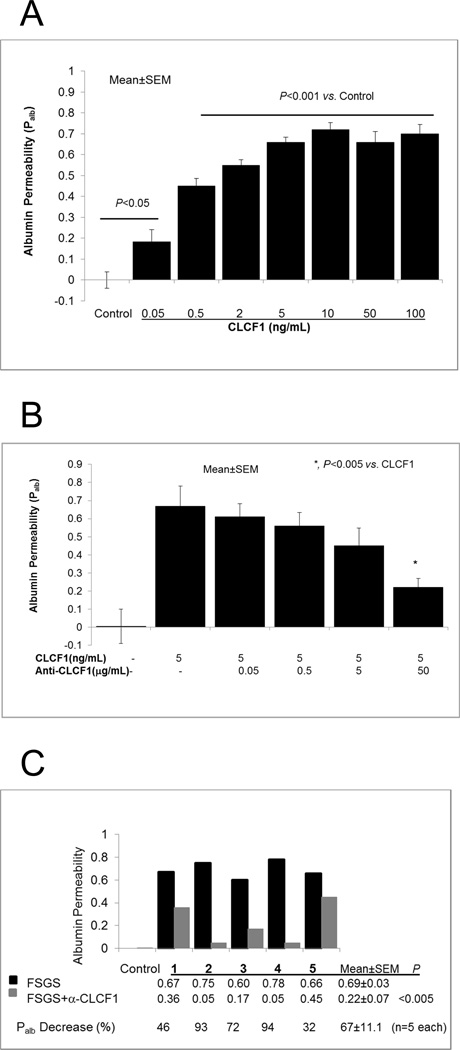Figure 1.
1A. CLCF1 caused an increase in glomerular albumin permeability (Palb). Isolated rat glomeruli were incubated with recombinant CLCF1 (0.05–100ng) for 15 minutes at 37°C. CLCF1 at 0.05ng/mL concentration caused significant increase in Palb (P<0.05 vs. control). Maximal increase was observed at 5–10 ng/mL (P<0.001). N= 15 glomeruli from 3 rats (5 glomeruli from each rat) in each group.
1B. Anti-CLCF1 antibody blocked the effect of CLCF1 on Palb. Isolated rat glomeruli were incubated with recombinant CLCF1 (5ng/mL) or with a mixture of CLCF1 and anti-CLCF1 monoclonal antibody (0.05–50µg /mL) for 15 minutes at 37°C. Control group included 5 µg human IgG. CLCF1 caused significant increase in Palb (P<0.001 vs. Control) that was maximally blocked by antibody at 50 µg /mL concentration (*, P<0.005 vs. CLCF1 alone). N= 15 glomeruli from 3 rats (5 glomeruli from each rat) in each group.
1C. Anti-CLCF1 antibody blocked the effect of sera from patients with recurrent FSGS. Isolated glomeruli were incubated with FSGS serum samples from five individuals (20 µL/mL each) or with a mixture of each serum sample and anti-CLCF1 antibody (50µg/mL) for 15 minutes at 37°C. Control group included 20µL/mL of pooled normal serum. Each pair of black and grey bars represents one sample. Black bars show that each FSGS serum sample caused significant increase in Palb (P<0.001 vs. Control). Each grey bar shows the effect of anti-CLCF antibody on the corresponding FSGS sample. Numeric values for Palb and percent change are shown under each pair of black and grey bars for each sample. Average of all five samples with SEM (mean±SEM) shows that anti-CLCF1 antibody significantly blocked the effect of FSGS serum (P<0.005, n=5 specimens). Five glomeruli from 1 rat were observed to calculate Palb for each sample.

